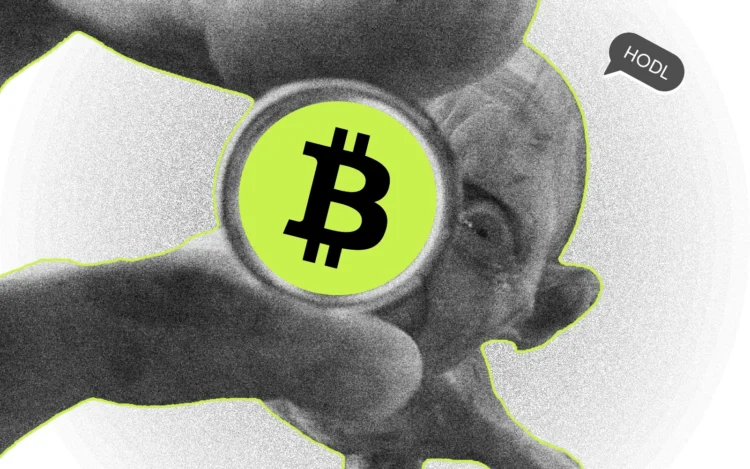In crypto, HODLing, a misspelt version of “hold” that became a meme, has grown into a cultural and strategic pillar for long-term investors. Originally coined in a 2013 Bitcoin forum post during a steep market drop, HODLing came to symbolize a defiant refusal to sell, no matter how volatile the market.
For early crypto adopters, Bitcoin HODLing proved remarkably effective. Those who resisted panic-selling during bear markets often reaped significant returns as the market rebounded and matured. The approach gained even more traction after the 2017 and 2020 bull runs, when HODLers saw their patience pay off.
But in 2025, the crypto market is far more complex. With growing institutional involvement, macroeconomic pressures, regulatory shifts, and faster-moving trends in DeFi and NFTs, many are asking: Does the HODL strategy still make sense in today’s evolving environment, or is it time to rethink long-term investing in crypto?
Bitcoin’s Market in 2025: What’s Changed?
Bitcoin has undergone notable shifts in accessibility, liquidity, investor participation, and on-chain behaviour this year as its role in global finance continues to evolve.
Spot ETFs Boost Accessibility and Liquidity
The introduction of US spot Bitcoin ETFs, most notably BlackRock’s iShares Bitcoin Trust, has significantly improved market access. Institutional inflows reached an estimated $6.35 billion in May 2025, adding more than 1.2 million BTC (6.13% of total supply) into ETF custody. This shift to regulated holdings has deepened liquidity, allowing both large and small crypto investors to participate more conveniently.
Institutional Participation and Smoother Price Patterns
With traditional funds, banks, and pension plans entering the market, Bitcoin now experiences more measured price behaviour. While volatility remains inherent, recent drops of over 17% were tempered by swift ETF-based stabilization. As such, “faster money” flows balance market moves, Bitcoin’s trading dynamics appear more structured and predictable.
On‑Chain Signals: HODL Waves & Holder Growth
From 2020 to 2024, Bitcoin price volatility has been way more than stock market indexes (like the S&P 500). In fact, it has been about three to four times more volatile than those broader markets.
However, even though Bitcoin is more volatile than the overall market, it’s actually less volatile than some big-name stocks. For example, over the past two years, Netflix’s stock bounced around more than Bitcoin. On average, Netflix’s price swings (volatility) were around 53%, while Bitcoin’s were around 46% over the same period.
While Bitcoin still experiences wild swings, it’s no longer the riskiest asset; some traditional stocks are even riskier.
Why People Still HODL
Even with today’s fast-moving markets, many investors stick to Bitcoin HODLing long-term, because the benefits often outweigh the temptations to trade short-term.
Bitcoin as Digital Gold
HODLers see Bitcoin as “digital gold,” a secure, scarce asset with capped supply. Just three halvings have already reduced new issuance from 50 BTC to 3.125 BTC per block, reinforcing its scarcity and long-term value proposition. This scarcity underpins confidence that Bitcoin will hold or increase in value as economies print more fiat.
ALSO READ: Modern Wealth Debate: Should You Bet on Bitcoin or Stick With Gold
Benefits of Halving Cycles
Bitcoin’s four-year halving cycle creates predictable supply shocks that historically triggered bull markets. After each halving, Bitcoin’s price historically surged. In 2012, BTC rose roughly 90x, from $12 to over $1,100 in 2013. After the 2016 halving, it climbed about 30x, reaching nearly $20,000.
The 2020 halving led to an 8x gain, with Bitcoin peaking around $69,000 in 2021. Many HODLers rely on long-term investing and ignore short-term volatility to stay invested across cycles.
Simplicity and Avoiding Market Timing
Trying to time entry and exit points in the crypto market is risky and stressful. Bitcoin HODLing is straightforward: buy and hold. By staying invested, HODLers sidestep emotional trading, buying lows, selling highs, and sleep easier knowing they’re following a clear, long-term strategy.
ALSO READ: Emotional Trading: How to Navigate Market Cycles With Confidence
Low Time Preference and Generational Wealth
HODLers embody low time preference, choosing long-term security over instant gratification. They view Bitcoin as a tool to build intergenerational wealth, protecting assets from inflation and enabling family legacies to endure. It’s not just about personal gain, it’s about securing the future.
Challenges to the HODL Strategy in 2025
In today’s crypto space, the traditional HODL approach faces new hurdles ranging from slower returns to macroeconomic threats.
Slower Growth and Diminished Returns
Bitcoin’s explosive gains of earlier bull runs, when it climbed hundreds or even thousands of percent, haven’t repeated in the post-2020 cycle. Recent performance reflects more gradual upward trends, offering returns that are muted compared to previous peaks. For many long-term holders, this means patience is essential, and gains come with fewer fireworks.
Opportunity Cost from New Yield Options
Markets have matured, offering ways to earn yield beyond pure price appreciation. DeFi lending and ETH staking provide annual returns ranging from 5–10%, while tokenized assets and emerging AI-driven yield strategies present even more sophisticated opportunities. Those who HODL without leveraging these avenues may miss out on passive income and protocol rewards.
Macro Risks on the Horizon
Global macroeconomic factors, such as interest rate hikes, persistent inflation, economic slowdowns, or crypto regulation, can undermine crypto performance. Even long-term holders aren’t insulated from market-wide shocks that prompt capital rotation into safer or higher-yield assets, which can pressure crypto valuations.
Newer Investors Questioning Long-Term Upside
As crypto gains mainstream attention, many wallets are new, and so are the expectations. Some newer crypto investors enter with short-term targets, while others question whether Bitcoin’s narrative is outdated amid increasing competition from alternative digital ventures and tokenized assets. This shift in mindset adds pressure to traditional HODL strategies from impatient market participants.
Alternatives Gaining Ground
As the cryptocurrency space matures, crypto investors are exploring new ways to utilise Bitcoin and diversify beyond simply holding (HODLing).
Active Trading & Algorithmic Bots
Automated trading bots and algorithmic strategies are now handling around 75% of market activity. These bots include arbitrage systems, trend-followers, grid traders, and AI-driven protocols, enabling round-the-clock execution, fast reactions, and emotion-free trading. While they offer efficiency and precision, they also require careful setup and risk management.
Bitcoin ETFs for Liquid & Regulated Exposure
Bitcoin spot ETFs in the U.S. now hold 6.13% of the total BTC, providing a familiar and accessible way for crypto investors to gain exposure to the cryptocurrency. These ETFs combine liquidity and institutional oversight, thereby bypassing the need for technical setup, wallets, or private key management, making them a preferred method for risk-conscious participants.
Yield-Generating Platforms & Bitcoin Lending
Crypto lending platforms, such as Nexo, BlockFi, Ledn, Aave, and Zest Protocol, enable Bitcoin holders to earn passive income. These services range from decentralized lending pools to peer-to-peer networks where BTC can be stored while generating returns.
Diversified Portfolios: Altcoins, Stablecoins & Real‑World Assets
Rather than sticking solely with Bitcoin, many are now building multi-asset portfolios that include altcoins like Ethereum or Solana, stablecoins, and tokenized real-world assets, such as tokenized Treasuries or equity funds. These diversified strategies provide exposure to emerging trends and yield opportunities that are not available through Bitcoin HODLing alone.
Hybrid Approaches: Adapting the HODL Philosophy
Long-term holders are evolving from pure HODLing to hybrid strategies that blend patience with tactical flexibility, helping them hold for the future while capturing shorter-term opportunities.
Partial HODLing + Rebalancing
Instead of holding 100% of your crypto, hybrid crypto investors allocate a fixed percentage to Bitcoin and rebalance periodically.
For instance, if your target is 70% BTC and 30% cash/stablecoins, you sell BTC when its share climbs above 70% and buy back when it falls below. This locks in gains, reduces risk, and preserves upside potential, all without emotional timing.
Taking Profits in Bull Markets, Buying the Dip
Rather than selling everything at once, many HODLers now take partial profits during rallies and reinvest in market dips. A common method is chaining profit-taking at set multipliers, such as cashing out 10–20% of gains at +40%, +80%, and so on, and then buying back when the market corrects. This rhythm, “sell half your profits, buy the dip,” enhances returns while maintaining a long-term stake.
Using Bitcoin as Collateral
To access liquidity without selling, some HODLers use Bitcoin-backed loans through platforms like Coinbase and DeFi protocols (e.g., SALT). They can borrow stablecoins or fiat using BTC as collateral, with no immediate sale and no capital gains liability.
Be cautious of margin calls during downturns; your collateral could be liquidated if the BTC value drops significantly.
Staking BTC or Wrapping It
Hybrid crypto investors are increasingly earning yield from their BTC. Options include staking-wrapped Bitcoin on Layer 2 chains (e.g., Core’s lstBTC with 3–6% yield), or using wrapped tokens like wBTC to lend, provide DEX liquidity, or collateralize loans in DeFi. This adds passive income to your strategy, even while holding your core assets long-term.
Conclusion
In 2025, smart investors aren’t just holding blindly; they’re adapting. While Bitcoin HODLing remains a powerful strategy rooted in long-term conviction, the crypto space has matured. With new financial tools, more market data, and evolving macroeconomic forces, the most successful participants are those who combine patience with flexibility.
Whether you choose to hold, trade, stake, or diversify, the key is alignment. Review your personal goals, timeline, and the level of risk you’re truly comfortable with. Crypto still offers immense opportunity, but how you approach it should evolve with the times.
Disclaimer: This article is intended solely for informational purposes and should not be considered trading or investment advice. Nothing herein should be construed as financial, legal, or tax advice. Trading or investing in cryptocurrencies carries a considerable risk of financial loss. Always conduct due diligence.
If you would like to read more articles like this, visit DeFi Planet and follow us on Twitter, LinkedIn, Facebook, Instagram, and CoinMarketCap Community.
Take control of your crypto portfolio with MARKETS PRO, DeFi Planet’s suite of analytics tools.”





















